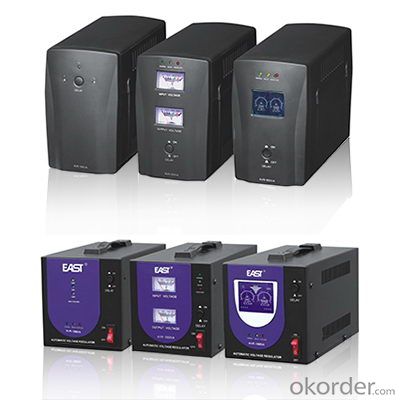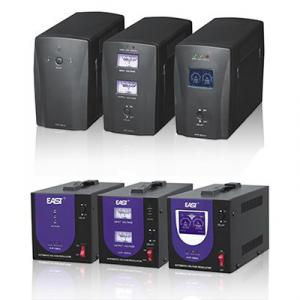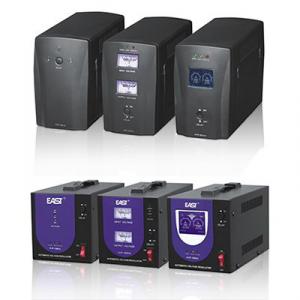Solar Power Inverter AVR 500-5000VA 2015 Very Popular CE Excellent Quality Approved
- Loading Port:
- China main port
- Payment Terms:
- TT or LC
- Min Order Qty:
- 1 pc
- Supply Capability:
- 1000 pc/month
OKorder Service Pledge
OKorder Financial Service
You Might Also Like
| AVR 500-5000VA |
AVR series AC automatic regulators apply the advanced control technology with well qualified components It has the features of wide input voltage compatibility, high reliability, output voltage stabilizing, energy saving ect....; it has over voltage and low voltage protection and delayed output protection ect.. it could supply stabilized power to lights, TVs, air-conditioners, refrigerator, computers and duplicating machines and other household equipment in schools, offices, hotels, meeting rooms where the stabilized voltage is needed. |
● Classic series, EI transformer, relay type
● Input and output voltage LED/Meter/LCD display
● High temperature protection
● Circuit breaker protection
● Efficiency: 98%

MODEL | 500VA | 800VA | 1000VA | 1500VA | 2000VA | 3000VA | 5000VA | |
Input | ||||||||
Phase | Single Phase+N+GND | |||||||
Voltage Range | 140Vac-270Vac (Option:100-270V) | |||||||
Output | ||||||||
Voltage Range | 200-240V(Empty Load) | |||||||
Frequency | 50/60Hz | |||||||
Over Voltage Protection | 250V±5V (Overvoltage indicator on, Output off ) | |||||||
Undervoltage Protection | 180V±5V (Overvoltage indicator on, Output off ) | |||||||
Others | ||||||||
Efficiency | ≥95% | |||||||
Display Mode | LED indicator light; Pointer voltmeter / LCD display (selectable) | |||||||
Input/Output Setting | Plug/ Socket | Terminal blocks | ||||||
Time-Delay | Short delay : <3 secs; long delay: 3mins | |||||||
Output Short Circuit Protection | Fuse / Breaker | |||||||
Waveform Distortion | No additional waveform distortion | |||||||
Insulation Resistance | >2MΩ | |||||||
Dielectric Strength | Low frequency sine voltage 1500V for 1 minute ( without phenomena of breakdown and flashover ) | |||||||
Ambient Temperature | -10℃~±40℃ | |||||||
Relative Humidity | ≤95% | |||||||
Working | Continuing Working | |||||||
Dimension(W×D×H) mm | Metal Case | 125×230×135 | 143×258×185 | 210x291x201 | 229x345x220 | |||
Plastic Case | 100×215×160 | —— | ||||||
Net Weight (kg) | Metal Case | 2.5 | 2.9 | 3.1 | 5.4 | 6.5 | 9.2 | 13.0 |
Plastic Case | 2.1 | 2.5 | 2.7 | —— | ||||
Packing Dimension (W×D×H) mm | Metal Case | 176×280×207 | 192×310×252 | 262x343x273 | 271x396x303 | |||
Plastic Case | 145×265×229 | —— | ||||||
Gross Weight(kg) | Metal Case | 2.8 | 3.2 | 3.4 | 5.6 | 6.7 | 9.6 | 13.55 |
Plastic Case | 2.4 | 2.8 | 3.0 | —— | ||||
Quantity/20ft | 2400PCS | 1600PCS | 900PCS | 730PCS | ||||
· Q. What is an UPS and What it is for ?
An uninterruptible power supply (UPS) is a device that allows your computer or telephone switch or critical equipement to keep running for at least a short time or longer time when the primary power source is lost. It also provides protection from power surges, spikes, brownouts, interference and other unwanted problems on the supported equipment.
· Q. How long the UPS to run when power goes?
This can take 3 paths.
1.You can pick a UPS that is rated for pretty much the full VA you need so it will be running at 100% of capability and will thus last 'n' minutes.
2.You can pick a UPS that is rated at a much higher VA value than you really need so, for example, is running at 50% of capability and will thus last for longer than the UPS from option 1.
3.You can use extra external battery packs to run for longer. If charging capability allows, the more and the bigger batteries you take with, the longer time UPS runs.
or using a generator after about 6 hours, it will be more cost-effective, with a short runtime UPS to bridge the generator start-up gap.
- Q:Can a solar inverter be used in areas with high humidity and salt air exposure?
- Yes, a solar inverter can be used in areas with high humidity and salt air exposure. However, it is important to choose a solar inverter that is specifically designed for such conditions, as these factors can potentially impact the performance and lifespan of the inverter. It is advisable to consult with a professional to ensure the selection of a suitable solar inverter for areas with high humidity and salt air exposure.
- Q:Can a solar inverter be connected to a generator?
- Yes, a solar inverter can be connected to a generator. This can be useful in situations where solar power is not sufficient or unavailable, allowing the generator to supplement the power supply.
- Q:How does a solar inverter handle voltage phase imbalance in the grid?
- A solar inverter handles voltage phase imbalance in the grid by continuously monitoring the grid's voltage and frequency. If it detects any phase imbalance, it adjusts its output to balance the voltage across all phases. This ensures that the power generated by the solar panels is synchronized with the grid and prevents any issues that may arise due to phase imbalances, such as equipment damage or power quality issues.
- Q:Can a solar inverter be used with different types of communication interfaces?
- Yes, a solar inverter can be used with different types of communication interfaces. Many modern solar inverters are designed to be compatible with various communication protocols such as Wi-Fi, Ethernet, RS485, and Zigbee. This allows for easy integration and monitoring of the inverter with different types of communication systems and devices.
- Q:How does a solar inverter handle power surges or fluctuations?
- A solar inverter handles power surges or fluctuations by using advanced circuitry and protective measures. It typically includes surge protection devices that can absorb excessive voltage spikes, diverting them away from the system. Additionally, the inverter continuously monitors the grid voltage and adjusts its own output accordingly to maintain a stable and safe supply of electricity.
- Q:What is a solar inverter?
- A solar inverter is a device that converts the direct current (DC) electricity generated by solar panels into alternating current (AC) electricity that can be used to power household appliances and be fed back into the grid.
- Q:How does a solar inverter handle voltage regulation during high demand?
- A solar inverter handles voltage regulation during high demand by carefully monitoring the voltage levels from the solar panels and adjusting its output accordingly. When there is high demand, the inverter can increase the voltage to meet the required levels. Additionally, some advanced inverters also have features like reactive power control and voltage regulation algorithms to ensure stable voltage supply during high demand situations.
- Q:How does a solar inverter handle voltage sags or swells in the grid?
- A solar inverter handles voltage sags or swells in the grid by continuously monitoring the voltage levels. When it detects a sag or swell, it adjusts its internal circuitry to regulate the output voltage accordingly. This ensures that the connected solar panels continue to operate within their optimal voltage range, minimizing any negative impact on the overall power generation system.
- Q:How does a solar inverter handle sudden changes in solar irradiance?
- A solar inverter handles sudden changes in solar irradiance by constantly monitoring the input voltage and adjusting its output power accordingly. It employs maximum power point tracking (MPPT) algorithms to optimize the energy conversion from the solar panels. When there is a sudden increase or decrease in solar irradiance, the inverter quickly adapts by regulating the voltage and current to maintain a stable and efficient output. This ensures that the generated solar power is effectively utilized and protects the system from potential damage caused by voltage fluctuations.
- Q:Can a solar inverter be used with concentrated photovoltaic systems?
- Yes, a solar inverter can be used with concentrated photovoltaic systems. Concentrated photovoltaic systems use lenses or mirrors to concentrate sunlight onto high-efficiency solar cells. The solar inverter's role remains the same in converting the DC power generated by the concentrated photovoltaic system into AC power that can be used for various applications.
1. Manufacturer Overview |
|
|---|---|
| Location | |
| Year Established | |
| Annual Output Value | |
| Main Markets | |
| Company Certifications | |
2. Manufacturer Certificates |
|
|---|---|
| a) Certification Name | |
| Range | |
| Reference | |
| Validity Period | |
3. Manufacturer Capability |
|
|---|---|
| a)Trade Capacity | |
| Nearest Port | |
| Export Percentage | |
| No.of Employees in Trade Department | |
| Language Spoken: | |
| b)Factory Information | |
| Factory Size: | |
| No. of Production Lines | |
| Contract Manufacturing | |
| Product Price Range | |
Send your message to us
Solar Power Inverter AVR 500-5000VA 2015 Very Popular CE Excellent Quality Approved
- Loading Port:
- China main port
- Payment Terms:
- TT or LC
- Min Order Qty:
- 1 pc
- Supply Capability:
- 1000 pc/month
OKorder Service Pledge
OKorder Financial Service
Similar products
New products
Hot products
Hot Searches
Related keywords
































